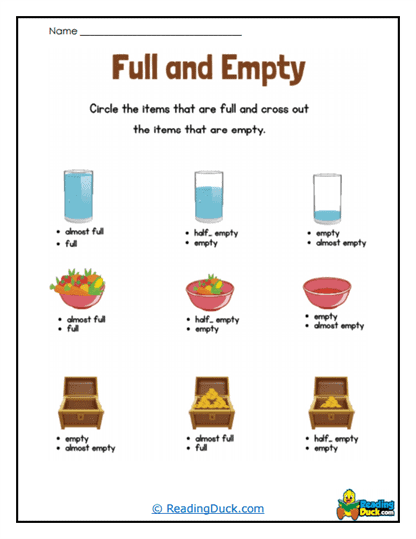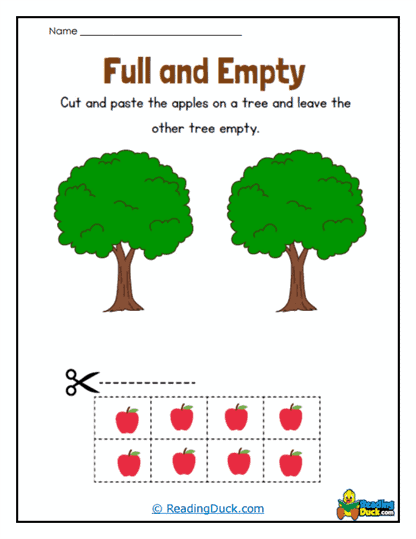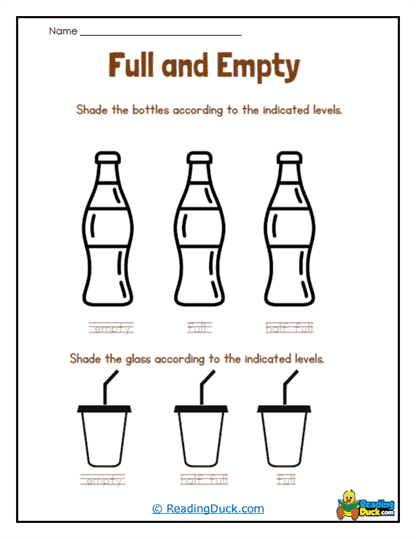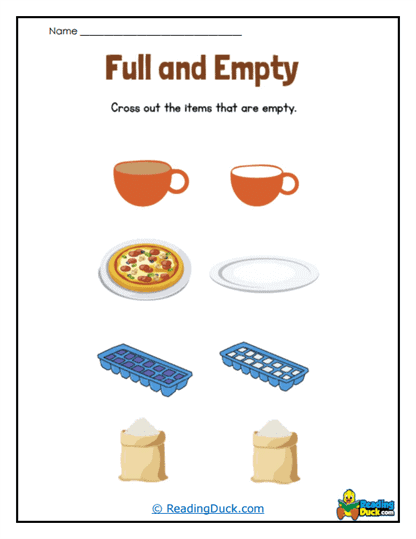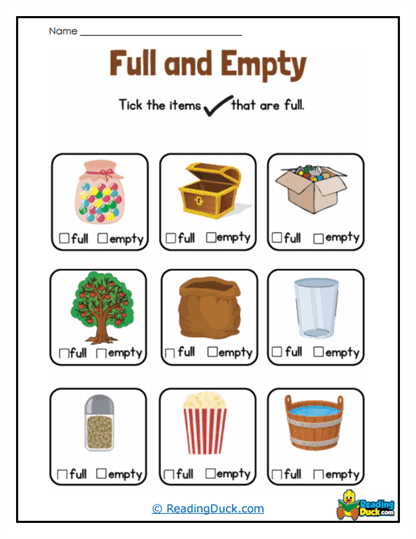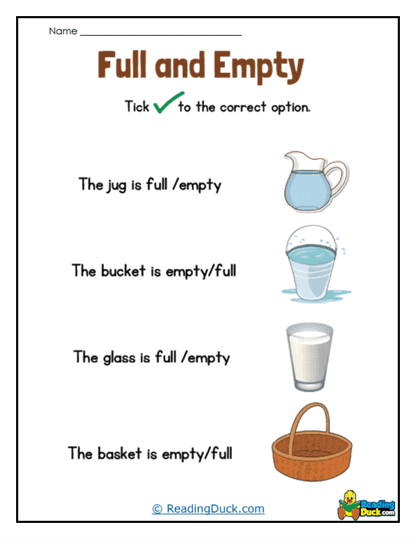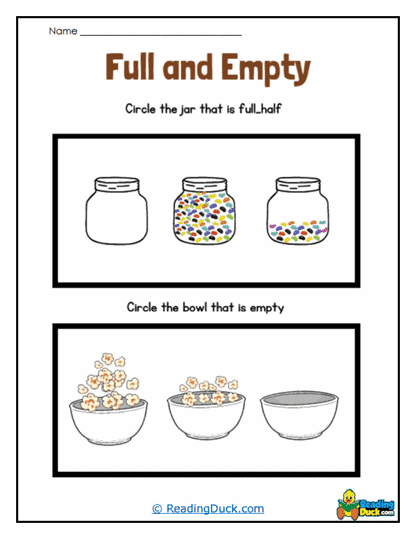Empty vs. Full Worksheets
About Our Empty vs. Full Worksheets
These worksheets will help young learners understand the concepts of fullness and emptiness. These worksheets are tailored for early elementary students, focusing on building a foundational understanding of quantity comparison. By engaging with these worksheets, students learn to visually assess items as either "full" or "empty" and apply these observations to different contexts. This understanding of quantity and spatial perception lays an important groundwork for later mathematical concepts, like measurement, volume, and data analysis.
Each worksheet typically presents images of various objects in both full and empty states, such as baskets, jars, shopping carts, and glasses. For example, one worksheet might show a shopping cart with groceries (full) next to an empty cart, asking students to circle the full one. This visual learning style is especially beneficial for younger students who are beginning to develop an awareness of their surroundings and how objects can change in quantity or capacity.
The visual comparisons in these worksheets make abstract ideas like fullness and emptiness more concrete. Young students can grasp these concepts by directly interacting with images of everyday items. The worksheets include familiar items—like popcorn buckets, drinking glasses, and containers—that children encounter in their daily lives, making the learning experience more relatable and engaging.
These worksheets also offer a great opportunity for educators to discuss the importance of recognizing different quantities and their practical implications. For instance, understanding that a full glass holds more than an empty one can lead to discussions about volume, weight, and even conservation of resources in real-world settings. This experiential learning makes "Empty vs. Full" worksheets an excellent tool for developing foundational math skills and life skills simultaneously.
Types of Exercises
The worksheets include a variety of exercises that cater to different learning styles and grade levels. Common activities in these worksheets involve circling or crossing out objects based on their fullness or emptiness, comparing items, and making choices about quantity. By working through these exercises, students learn to identify, distinguish, and categorize objects, a skill that is essential for developing critical thinking and logical reasoning.
In one type of exercise, students are asked to circle items that are full and cross out those that are empty. For instance, a worksheet might display a set of objects like a jar full of candies, a basket with toys, an empty glass, and an empty basket. The task for the student is to circle the full objects (like the jar of candies) and cross out the empty ones. This type of exercise helps children practice attention to detail and strengthens their ability to follow directions while learning to differentiate between fullness and emptiness visually.
Another popular exercise asks students to tick or check items that are full among a pair of images. For example, a worksheet may feature two images side by side-one of a popcorn bucket filled to the brim and another almost empty. The student's task is to place a check mark next to the full item. These types of comparison exercises support students' abilities to make choices based on visual assessment, a skill that extends to many real-world scenarios, such as selecting items of sufficient quantity or quality.
More interactive exercises, like those that involve cutting and pasting images (e.g., placing apples on a tree to show it as "full" and leaving one tree empty), add a kinesthetic component to learning. These hands-on activities are ideal for young children who benefit from tactile learning and add variety to the worksheet activities. They also encourage fine motor skills development, as students practice careful cutting and pasting.
Some worksheets require students to color objects based on instructions. For instance, they might be asked to color one glass blue and leave another empty. This exercise reinforces both the concept of fullness and an understanding of following directions. Additionally, coloring worksheets introduce a creative element to the activity, helping students express their understanding in a visual and artistic way.
Skills Gained
Completing empty vs. full worksheets helps students build a variety of essential skills that are crucial for both academic success and everyday life. Through repeated practice, students gain proficiency in several areas, including critical thinking, decision-making, observation, and problem-solving. These worksheets offer a blend of cognitive, visual, and motor skill development, making them versatile educational tools.
One of the primary skills students develop is the ability to compare and contrast. Identifying full and empty objects requires students to make distinctions based on visual clues, which hones their observational skills. By learning to differentiate objects based on fullness, students can apply similar skills in other contexts, such as identifying patterns, sorting, and classifying objects—foundational skills in mathematics and science.
Another key skill gained through these exercises is decision-making. When students are tasked with selecting items that are full or empty, they must make choices based on their observations. This simple activity fosters an early understanding of logical reasoning, as they consider why one item fits a category over another. Decision-making exercises build confidence, empowering students to trust their judgment and reinforcing the importance of making thoughtful choices.
Fine motor skills are also developed through certain worksheet activities, especially those involving cutting, pasting, or coloring. These activities require precise hand movements and coordination, which are essential for writing, drawing, and other tasks requiring dexterity. For instance, carefully coloring an object to show it as "full" or cutting out apples to paste on a tree improves hand-eye coordination, patience, and concentration.
These worksheets promote problem-solving abilities by encouraging students to think critically about each task. When identifying objects that are full or empty, students learn to analyze visual information, apply given instructions, and make decisions based on their findings. These problem-solving skills will serve them well as they encounter more complex challenges in subjects like math, reading comprehension, and science.
Real World Applications
Understanding the concepts of empty and full has practical applications beyond the classroom, making these worksheets relevant to real-life situations. Students who master these skills are better equipped to make judgments about quantity, an ability that is useful in numerous everyday contexts. Recognizing when something is full or empty teaches students to be mindful of resources, which can contribute to more responsible behavior in areas such as environmental awareness and resource management.
One real-world application of these skills is in grocery shopping or resource allocation. When students learn to differentiate between full and empty objects, they can better understand the concept of quantity. For instance, knowing when a bottle of milk is nearly empty or a container of cereal is full helps in planning and decision-making during shopping trips. This practical understanding of quantity can foster a sense of responsibility and awareness about food wastage and resource use.
Another area where these skills are applicable is in measuring and using liquids. Understanding when a cup, jug, or bottle is full versus empty is fundamental for following instructions in activities like cooking or pouring beverages. Knowing not to overfill a container or recognizing when something needs a refill are practical life skills that students can begin practicing at a young age, even in simple tasks like filling a glass of water.
These skills are also valuable in data interpretation and scientific observation. In later academic settings, students may be required to measure quantities, assess volumes, or compare levels in experiments and projects. The foundational skills learned in these worksheets—observing, comparing, and determining fullness or emptiness—prepare students for these more advanced tasks by instilling a basic understanding of measurement and quantity assessment.
In social settings, being aware of the concepts of fullness and emptiness can also foster empathy and sharing behaviors. For example, recognizing that someone else's glass is empty while theirs is full can lead students to develop considerate habits, such as offering to share or refill a friend's cup. This awareness of others' needs is a subtle but valuable lesson in social responsibility and kindness.
